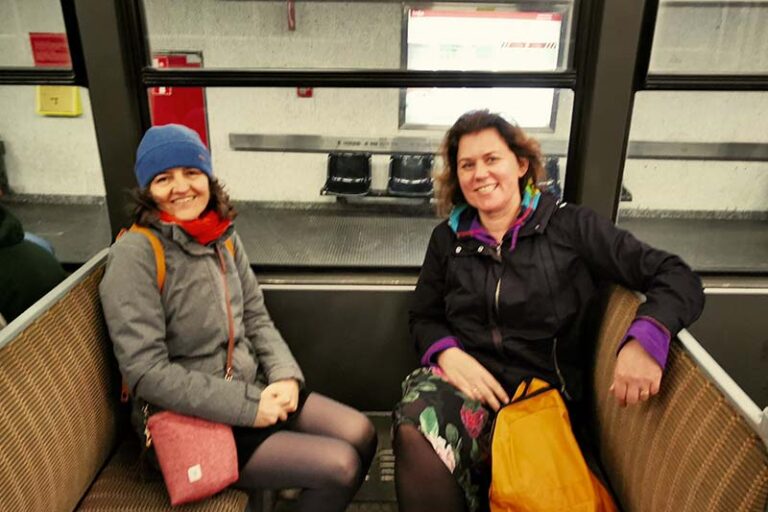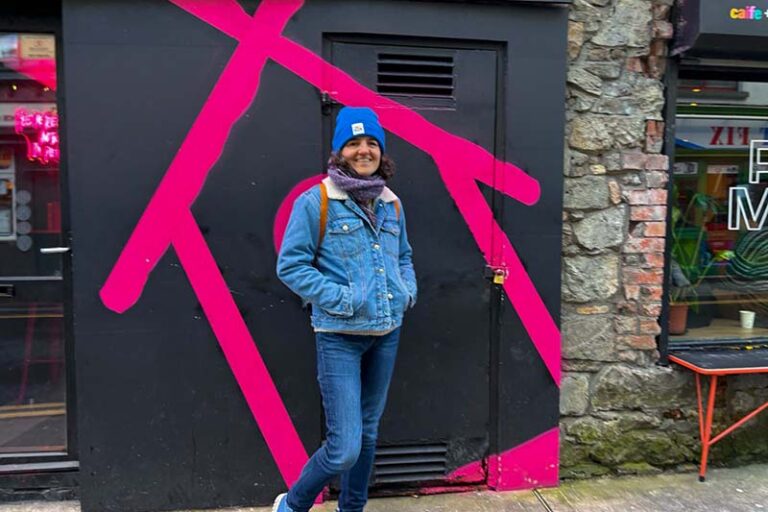He is a painter, his job is to paint. For himself, for painting, because that is his vocation, because he would not be able to not transform what he sees into the painting works.
– wrote Henri Perruchot in the book “Cézanne”.
This is one of my favourite publications. It made me want to go to Aix-de-Provence, a small town in France, where a boy was born, who at the age of five scribbled with charcoal on the walls of what surrounding him, and people were surprised how realistic it was.
Strange products of the mind can become reality
We landed on the Cote d’Azur without any plans. So because we were in France, one day we spend almost all the money we had on tickets for the train from Nice to Marseille and later bus to Aix-en-Provence. We passed over 200 kilometres just to see the light that Paul Cézanne saw and drink coffee at Café des Deux Garçons, where this particular artist used to sit in the nineteenth century.
The light in Aix is really special – so said a French woman we stayed with at in Nice.

Straight from a homely sofa
Three years have passed quickly. Now, we all have to stay at home in quarantine, but I want to visit the town which has a sluggish and a bit of melancholy charm, where the whispers of fountains murmur gently eternal songs.
So I read the story about Cézanne again.
The Provencal plane trees in Avenue Mirabeau are not as big as now. Paul is wandering around with his friends Emil Zola and Baptistin Baille.
They climb the slopes of Mount Saint Victoria, wander the ravine Infernets (Le Ravin des Infernets), venture even to the nearby town of Gardanne. They recite poetry and dreams in order to finally land in the narrow streets of Aix. They are only fifteen years old.
“Life is like a ball that doesn’t know where it will go“
– wrote Emil Zola.
Cézanne struggled with many things in his life: with the vision of his father who wanted him to take over the family bank in the future, with pessimistic moods, the crooked glances of people, but the thing he struggled with most was painting. If he failed to paint what he felt and what he saw exactly, he painted with even greater fury to finally discover new forms of displaying nature on canvas. He was a loner painter, The Parisian Art Institutes did not like him, because his paintings seemed completely different and ahead his time compared to the expected of canon.

L’Événement, 1866.
“He started painting as a discoverer of unknown lands”
Cézanne never gave in to fashion. He did not fall in love with Paris, though he felt more free there or at Aix, but – he always returned to his dear town in Provance. He loved this place, although people there didn’t understand him and sneered at him. But Cézanne never ceased to transform his vision. He could paint for hours, even in pouring rain. Painting was more important to him, even more than family with whom he had a strange relationship. He died painting a picture.
Today in Aix we can discover the paths he has followed. Even the cinema has his surname.

I sat in the garden of Paul’s favourite cafe and stared at the light for a long time.
The rays gently exposed the beige walls of houses, signposts, flagstones, dry leaves on Mirabeau Avenue, and even the water in my glass. For the first time in my life I saw the combination of summer and golden autumn. I can also see the same colours in Cézanne’s paintings.
Thanks to the book of the French writer, and my own memories of Aix, I can imagine a bit of Paul’s life and his passion for painting.
For me writing is a similar thing. I feel an irresistible desire to describe everything, but I also have to struggle so many times, with form, with limited word resources, with myself, because I want to express what I feel and paint with words, what I see outside and inside.

Perruchot’s book, written lightly as a novel, can be sobering
Do we realize in life what we want to really do, regardless of difficulties? or Do we prefer to go through life comfortably, but without struggling with form, stereotypes, fashions, comforts, opinions, time… Write here everything with which you struggle when your vocation calls you.
In the example of Paul Cézanne’s life, I understood that pursuing any passion is a very difficult thing, but fighting is an inseparable part of this path on which we live fully.

Światło Paula Cézanne’a
Jest malarzem, jego zadaniem jest malować. Dla siebie, dla malarstwa, bo takie jest jego powołanie, bo nie umiałby nie przetwarzać tego co widzi, na dzieła malarskie.
– pisze Henri Perruchot, w książce „Cézanne”.
To jedna z moich ulubionych pozycji, która sprawiła, że zapragnęłam pojechać do Aix-de-Provence, miasteczka we Francji, gdzie urodził się chłopiec, który już w wieku pięciu lat gryzmolił węglem na murach to co go otaczało i ludzie nie mogli się nadziwić jakie to wszystko realistyczne.
Wytwory umysłu dziwnym trafem mogą stać się rzeczywistością
Bez wcześniejszych planów wylądowaliśmy na Lazurowym Wybrzeżu. Skoro więc byliśmy we Francji, pewnego dnia wsiedliśmy w pociąg i przejechaliśmy ponad 200 kilometrów z Nicei do Marsylii, a stamtąd autobusem do Aix-en-Provance.
Wydaliśmy prawie wszystkie pieniądze na bilety tylko po to, aby zobaczyć światło, które widział Paul Cezanne oraz wypić kawę w Café des Deux Garçons, gdzie w XIX wieku przesiadywał ten szczególny artysta.
– W Aix światło jest naprawdę wyjątkowe – powiedziała nam Francuska, u której zatrzymaliśmy się w Nicei.
Prosto z pluszowej kanapy
Minęły trzy lata. Siedzimy w domu na kwarantannie, a ja znów chcę odwiedzić miasto, które ma ospały, nieco smętny wdzięk, gdzie szept fontann szemrze łagodnie odwieczne pieśni.
Czytam więc na nowo opowieść o życiu Cézanne’a.
Prowansalskie platany w alei Mirabeau nie są jeszcze tak wielkie, jak teraz. Paul włóczy się po okolicy ze swoimi przyjaciółmi Emilem Zolą i Baptistin Baille. Wdrapują się na stoki góry Świętej Wictorii, wędrują wąwozem Infernets (Le Ravin des Infernets), zapuszczają się nawet do pobliskiego miasteczka Gardanne, recytują poezję i marzą, aby ostatecznie wylądować w wąskich uliczkach pogrążonego we śnie Aix. Mają raptem piętnaście lat.
„Życie jest jak kulka, która nie wiadomo gdzie się potoczy”
– napisał Emil Zola.
Cézanne zmagał się w życiu z wieloma przeciwnościami: z wizją ojca, który chciał, by syn przejął po nim bank, z pesymistycznymi nastrojami, z drwiną innych. Jednak przede wszystkim zmagał się z malarstwem. Jeśli nie udawało mu się namalować tego co czuł i tego co dokładnie widział, to malował z jeszcze większą zaciekłością by w końcu odkryć nowe formy wyeksponowania natury na płótnie. Był malarzem samotnikiem, paryskie instytuty sztuki nie lubiły go, bo jego malarstwo wyprzedzało dotychczasowe kanony.

„ Podchodził do malarstwa jak odkrywca do nieznanych mu ziem”
Cézanne nigdy nie ulegał modzie. Paryż go nie rozkochał, choć czuł się w nim swobodniej niż w Aix. Kochał swoje miasto i zawsze do niego wracał, choć ono go nie doceniało, a wręcz czasami szydziło z niego. Lecz Cézanne nie ustawał, aby oblec w kształty targające nim wizje. Potrafił malować godzinami, nawet w strugach deszczu. Malarstwo było dla niego ważniejsze, nawet od rodziny, z którą miał nieco dziwne stosunki. Umarł malując obraz.
Dziś w Aix możemy odkrywać ścieżki, którymi wędrował. Nawet kino nazwano jego nazwiskiem.
Przysiadłam w ogródku ulubionej kawiarni Paula i długo gapiłam się na światło.
Promienie delikatnie eksponowały beżowe ściany kamienic, szyldy, płyty chodnikowe, suche liście w alei Mirabeau, a także wodę w mojej szklance. Przyznam, że wtedy pierwszy raz w życiu widziałam połączenie lata i złotej jesieni. Podobną kolorystykę dostrzegam także w obrazach Cézanne’a.
Dzięki książce francuskiego pisarza oraz własnym wspomnieniom o Aix mogę wyobrazić sobie choć trochę codzienność Paula i wczuć się w jego pasję do malarstwa.
Dla mnie czymś takim jest pisanie. Czuję nieodpartą chęć opisywania wszystkiego, ale zmagam się, z formą, zasobem słów, talentem, samą sobą. Nie jest mi łatwo namalować słowami, to co naprawdę widzę na zewnątrz oraz w środku.

Książka Perruchot’a napisana lekko jak powieść otrzeźwia
Czy staramy się urzeczywistniać w życiu, to do czego czujemy się stworzeni? Czy chcemy się zmagać z formą, stereotypami, modami, wygodami, opiniami, czasem… Wpiszcie tu to z czym się ścieracie, gdy wzywa Was powołanie.
Na przykładzie życia Paula Cézanne’a zrozumiałam, że realizowanie swojej pasji to bardzo trudna sprawa, a zmaganie się jest częścią drogi, na której w pełni żyjemy.
Obraz tytułowy: “Mont Sainte-Victoire with Large Pine, 1887.
Cytaty z książki: Henri Perruchot “Cézanne”, PIW 1958.




